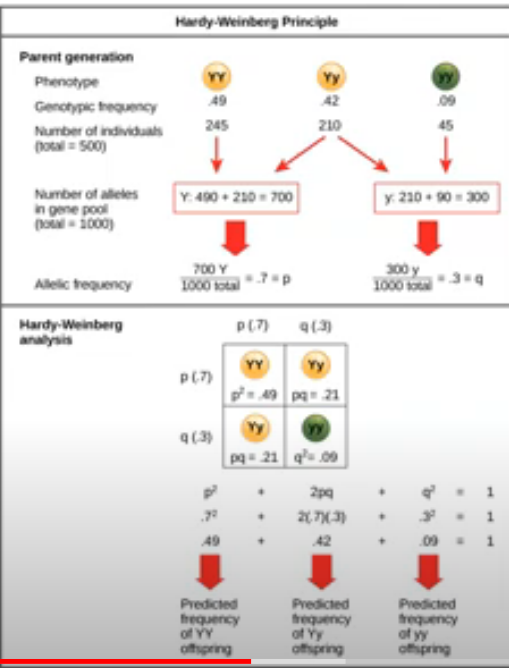10.3 - Gene Pools & Speciation
1/7
There's no tags or description
Looks like no tags are added yet.
Name | Mastery | Learn | Test | Matching | Spaced |
|---|
No study sessions yet.
8 Terms
Gene Pool
Gene pool: all of the genes and their different alleles that are present in an interbreeding population
Species are a group of organisms that can reproduce fertile offspring
Genes can be reproductively or geographically isolated from one another, creating multiple gene pools for one species
Genetic equilibrium: all of the population has an equal chance of contributing to the gene pool
Gene (allele) frequency
Evolution requires a change in gene frequency
when all genotypes in a population are known, we can count the number of each type of allele
Allele frequency can be between the values 0-1
1: all members of the population are homozygous, showing the same phenotype
Evolution
Evolution: cumulative change in heritable characteristics of a population over time
Requires a change in allele frequencies in populations
Single gene locus or multiple gene loci
For basic mechanisms of evolutionary change to operate, there must be genetic variation within the population.
Sources of genetic variation:
Gene flow: movement of genes from one population to another.
Sexual reproduction: new allele combinations, reshuffling of gamete formation and random fertilization
Mutations: permanent alteration in the DNA base sequence of a genome, which can accumulate
Selection pressure
Selection pressure: environmental factors that act on certain phenotypes
Directly impacts natural selection and acts as a driving force for evolution
Biotic (living) or abiotic (nonliving) factors reducing chances of survival only allows the fittest to survive, causing a change in the allele frequency after a few generations
Directional vs stabilizing vs disruptive selection
Stabilizing: selection pressures act to remove extreme varieties
Ex: average birth weight in human babies is preferred over low or high birth weight
Disruptive: removes intermediate varieties, favoring the extremes
Sometimes advantageous to have two opposing varieties of a phenotype rather than one
Directional: selection of one extreme over the other, usually because it is better adapted
Ex: peppered moths
Speciation
Formation of a new species by the dividing of a new population
Reproductive isolation can be temporal (very similar species but their way of life doesn’t allow reproduction), behavioral, or geographic
Can be slow or abrupt
Reproductive isolation: inability of two organisms of two different species to mate and produce fertile offspring
Calculating allele frequency
All individuals have at least 2 alleles for each gene
Total number of alleles is twice that of the number of individuals in the population
Allele frequency total is 1.0
Allele denoting dominant trait is p and recessive is q
p2 + 2pq + q2
Allele frequency stays constant when random mating occurs, population is large, all phenotypes survive equally well
Populations staying constant are in Hardy-Weinberg principle

Polyploidy & Speciation
Polyploidy can be caused by the total non-disjunction (homologous chromosomes fail to separate) of chromosomes during mitosis or meiosis
More than normal set of chromosomes
Once an organism becomes a polyploid, they are immediately isolated from the original species